The Pingxi Branch Railway Line has been a favorite stomping ground of mine for many years, providing many happy days of hiking and exploring. Judging from the huge crowds that now shuffle each day along the quaint main street of its biggest draw, Shifen Township (十分) in New Taipei City, it’s hard to believe there’s anywhere in the area that hasn’t been discovered by the masses. Indeed, the days when some of the finest hikes in the area — such as the wonderful Sandiaoling Waterfall Walk (三貂嶺瀑布步道) — were relatively quiet escapes are long gone.
Since this is Taiwan, however, new and exciting places to discover can be found even in the most popular areas. And several little-known beauties languish within a stone’s throw of Shifen railway station, almost unknown to this day.
In fact one of the finest natural wonders in the Shifen area was, until a year or two ago, a real pain to get to, and thus virtually unknown. This is the Nanshanping Bat Cave (南山坪蝙蝠洞). It lies just a few hundred meters from the nearest road, yet the great cave is extremely well concealed by the dense jungle, and before the new trail was cut by a local hiking club in 2016, getting there was a short but difficult adventure only suitable for experienced hikers.
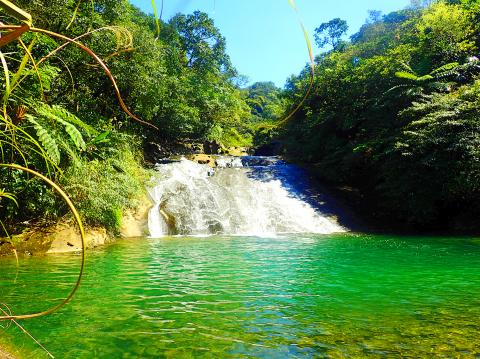
Photo: Richard Saunders
It doesn’t help that to this day the cave (or rather caves, for there are in fact two), is described in only a couple of online sources, and the only printed hiking map of the area marks it a kilometer west of its actual position. No wonder it remains so little known.
TRAILHEAD TO CAVE
The trailhead is easy enough to find, if you know where to look. Get off bus 795 at Fude Temple (福德宮站), two stops before Shifen village. Just off the road is a colorful Land God shrine. Walk through the metal temple gate and along the tarmac road next to the shrine.
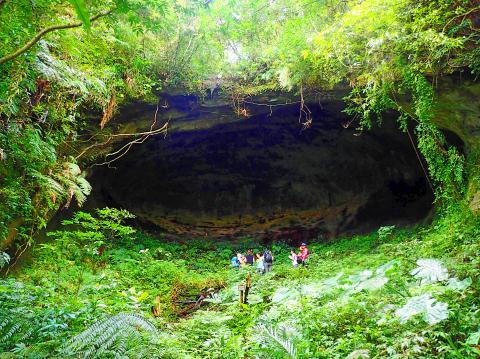
Photo: Richard Saunders
In a couple of minutes, the narrow road bends round to the right to end at an old brick farmhouse. On the left at the bend is a stream, culverted through an overgrown concrete channel with faux bamboo handrails. Follow an indistinct dirt trail along the right bank of the channel, and after a few meters it winds gently upwards into a grove of conifers.
Look out for the carcasses of sky lanterns which litter the woods, and, if you intend to come back the same way, consider taking a few of them back to the village and dumping them in the trash.
The path soon follows a small stream through the woods. Note the junction a little further on. The trail climbing the hillside on the left is the way up to the upper bat cave. Keep ahead along the path beside the stream, and at a second junction, turn left, down a slippery and rough dirt trail that crosses the little watercourse and then climbs the hillside opposite for a couple of minutes until the huge, gaping mouth of the cave yawns out of the arboreal gloom above.
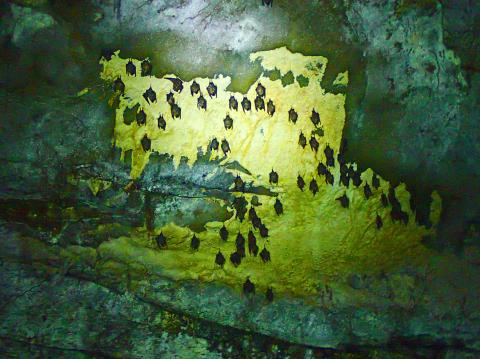
Photo: Richard Saunders
According to a local I met near the trailhead after my first visit to the cave, it was used during the World War II as an air raid shelter. If so, access must have been easier in those days.
It’s a very impressive sight, even though (like most of Taiwan’s so-called “caves”) it’s more of a very deep overhang than a true cave. Sadly, if there were ever any bats inside, they seem to have fled — probably the cave isn’t quite dark enough for their tastes and they’ve found deeper, darker places to make their home in the many abandoned coal mine shafts that dot the area’s forested mountainsides.
You will, however, find bats in the second bat cave (and it’s a real cave) concealed in the face of the steep, wooded hillside above. Retrace steps to the first junction, turn left, and follow the dirt trail steeply uphill for about 15 minutes.
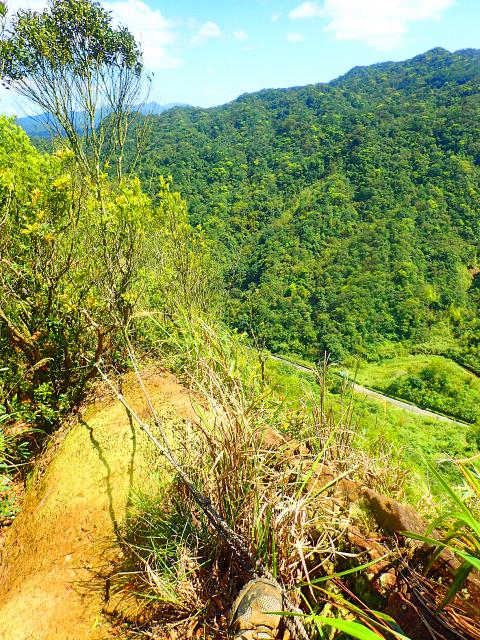
Photo: Richard Saunders
The cave entrance is far less impressive than the gaping mouth of the lower one, but go inside and the cave opens out quite a bit. Just enough light gets into the cave to illuminate the interior enough to dimly see its size, although to see the bats sleeping in the roof you’ll need to use a flashlight or head torch. If you do, be sensible and don’t shine it directly on them — the poor things are trying to sleep after all.
BACK TO SHIFEN
Above the upper Bat Cave the trail becomes steeper still, and it’s a tough climb for nearly 30 minutes to the conspicuous knife-edge ridge above Shifen village. Here the trail swings left along a precariously narrow blade of rock before dropping down to the highway just south of Shifen village after about an hour. Don’t even think of taking this trail unless you’re an experienced hiker and have good-quality walking shoes and good weather conditions.
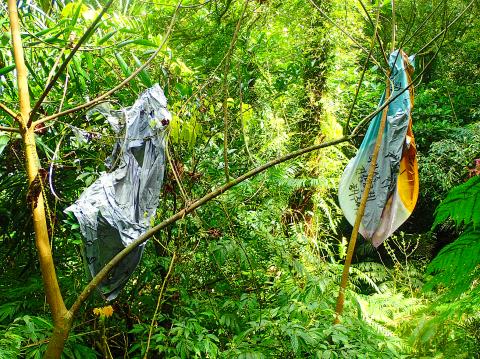
Photo: Richard Saunders
Turn left down the wide new highway, and it’s only a 15 minutes walk back to the packed streets of Shifen. On the way, though, pay a quick visit to the wide, smooth waterslide at Shifen Gorge (十分谷), a curious and once relatively popular spot that seems to have been forgotten these days.
Almost opposite the Shifen train station, a large stream empties into the Keelung River. Take the overgrown stone trail up the left bank of this stream for about five minutes. In years past, the waterslide was a popular summer destination with locals, who brought along boards or tea trays and slid down this slippery, smooth chute into the large pool at its base. The trail up there is now extremely overgrown and boggy in places, but not a big obstacle to the determined, especially on a baking hot, sunny day.
Richard Saunders is a classical pianist and writer who has lived in Taiwan since 1993. He’s the founder of a local hiking group, Taipei Hikers, and is the author of six books about Taiwan, including Taiwan 101 and Taipei Escapes. Visit his Web site at www.taiwanoffthebeatentrack.com.
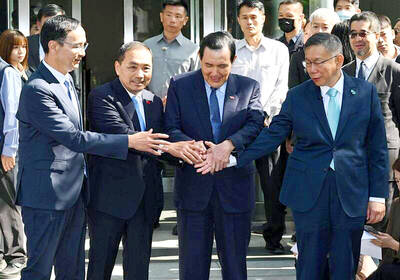
Has the Taiwan People’s Party (TPP) changed under the leadership of Huang Kuo-chang (黃國昌)? In tone and messaging, it obviously has, but this is largely driven by events over the past year. How much is surface noise, and how much is substance? How differently party founder Ko Wen-je (柯文哲) would have handled these events is impossible to determine because the biggest event was Ko’s own arrest on multiple corruption charges and being jailed incommunicado. To understand the similarities and differences that may be evolving in the Huang era, we must first understand Ko’s TPP. ELECTORAL STRATEGY The party’s strategy under Ko was

It’s Aug. 8, Father’s Day in Taiwan. I asked a Chinese chatbot a simple question: “How is Father’s Day celebrated in Taiwan and China?” The answer was as ideological as it was unexpected. The AI said Taiwan is “a region” (地區) and “a province of China” (中國的省份). It then adopted the collective pronoun “we” to praise the holiday in the voice of the “Chinese government,” saying Father’s Day aligns with “core socialist values” of the “Chinese nation.” The chatbot was DeepSeek, the fastest growing app ever to reach 100 million users (in seven days!) and one of the world’s most advanced and
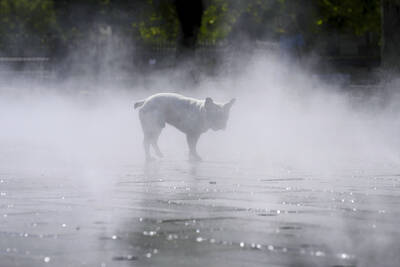
It turns out many Americans aren’t great at identifying which personal decisions contribute most to climate change. A study recently published by the National Academy of Sciences found that when asked to rank actions, such as swapping a car that uses gasoline for an electric one, carpooling or reducing food waste, participants weren’t very accurate when assessing how much those actions contributed to climate change, which is caused mostly by the release of greenhouse gases that happen when fuels like gasoline, oil and coal are burned. “People over-assign impact to actually pretty low-impact actions such as recycling, and underestimate the actual carbon

An internal Meta Platforms document detailing policies on chatbot behavior has permitted the company’s artificial intelligence creations to “engage a child in conversations that are romantic or sensual,” generate false medical information and help users argue that Black people are “dumber than white people.” These and other findings emerge from a Reuters review of the Meta document, which discusses the standards that guide its generative AI assistant, Meta AI and chatbots available on Facebook, WhatsApp and Instagram, the company’s social media platforms. Meta confirmed the document’s authenticity, but said that after receiving questions earlier this month, the company removed portions which stated